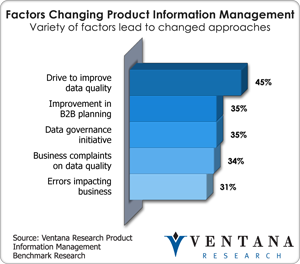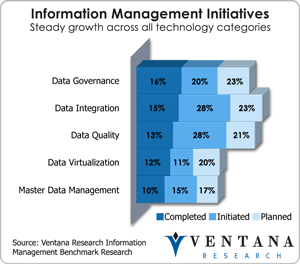Managing the access, storage and use of data effectively can provide
businesses a competitive advantage. Last year I outlined what the big deal is in big data,
as the initial focus on the volume, velocity and variety of data – what
my colleague Tony Cosentino calls the three V’s – is only one small
piece of how organizations should evaluate this technology. The more
balanced approach is to include what he calls the three W’s – the what, so what and now what,
which shifts the focus to an outcome-based view that can handle the
time–to-value urgency found in business. Big data analytics can help
assess the volume of data, while the velocity of data that is
potentially in-motion is best handled by what we call operational
intelligence. Beyond these, techniques and technology such as predictive
analytics and visual discovery facilitate extracting more value from
big data. Along with a wide variety of data, these tools help
organizations focus on optimizing information assets. We will soon
conduct benchmark research into information optimization to determine
how organizations are dealing with their information today and what
steps they are taking to improve. In-memory computing will surely be one
of those steps, as it can significantly improve the time-to-insight
equation.
Big data does not magically become valuable, nor is it easily
implemented. Organizations must realize they still require good
information management competencies that address the full lifecycle of
access and integration  across in-house and cloud computing resources. Our research into data in the cloud has
found that most organizations are not prepared to handle this broad,
distributed data dilemma and has become very important. Technology to
harvest and integrate data must become easier to use for both business
and IT users, which means overcoming the prevailing reliance on
spreadsheets, which our research has found is a larger data challenge than most people realize.
across in-house and cloud computing resources. Our research into data in the cloud has
found that most organizations are not prepared to handle this broad,
distributed data dilemma and has become very important. Technology to
harvest and integrate data must become easier to use for both business
and IT users, which means overcoming the prevailing reliance on
spreadsheets, which our research has found is a larger data challenge than most people realize.
Our research agenda for 2013 calls for us to examine not just the
forms of big data technology, but also the impact and value of big data
tools that organizations can use to maximize the value of their
information and drive better insights. Realizing the vision of greater
intelligence across processes and teams takes an investment of time,
effort and money. Accomplishing such a feat requires focusing on
information competencies to support big data effectively, which requires
an assessment of the information processes to deliver data to business
effectively. Our research into operational intelligence found
that the use of events is a critical part of the big data environment.
At the same time the skills of master data management and data governance do
not go away, and in fact become important to address the business
accuracy question that inevitably pops up when more data becomes
available to be utilized. Our research into product information management has found that the drive for data quality is changing organizations’  approaches,
and that a comprehensive information strategy using MDM and PIM
together across business and IT can yield significant benefits compared
to an IT-only approach. Our Product Information Management Value Index found
some startling results about which vendors really meet the business
needs of organizations. Product information is one of the many
priorities as well as customer, employee and finance that need to be
part of a big data effort and information optimization set of processes.
approaches,
and that a comprehensive information strategy using MDM and PIM
together across business and IT can yield significant benefits compared
to an IT-only approach. Our Product Information Management Value Index found
some startling results about which vendors really meet the business
needs of organizations. Product information is one of the many
priorities as well as customer, employee and finance that need to be
part of a big data effort and information optimization set of processes.
To embrace big data and optimize the use of information across an
entire enterprise requires not just competencies and methods to ensure
effective deployment, but also the ability to understand the business
cycles for information and design the technology accordingly. Our
research this year will examine the varying types of big data
technology, including data appliances, Hadoop, in-memory computing and
RDBMSes, all of which our big data research in
2012 indicated have a nice growth pattern going into 2013. The number
of Hadoop tools in particular has expanded dramatically in the last
year, making it easier for existing staffers to utilize that technology
without having to hire dedicated programmers, as was the case for early
adopters.
In addition, we have seen that large-scale in-memory computing
architectures can provide significant value when it comes to working
with big data. A new generation of data appliances arrived on the scene
in 2012. Of course it is critical to explore new methods to provide
analytics and gain insights from big data and not assume that your
existing providers will provide you a competitive edge with innovative
approaches. Also, businesses must not limit themselves to the use of
structured data when they can also utilize varying forms of content to
help get a more integrated view of information. Big data can become
strategic, but businesses need some technical acuity to design the best
possible architecture for their needs.
It will be critical to understand best practices for big data in 2013
and not get caught in the neverending cycle of evaluating technology.
IT organizations need to deliver value to business iteratively in order
to be seen as contributing to the value business expects from technology
investments. It is also critical that IT and business analysts work
together to find the right big data approach. They must reduce time
spent on data-related tasks; our technology innovation benchmark
research found that more than 40 percent of organizations currently
spend too much. Supporting a variety of data will be critical, as even
location data and resulting analytics, which we are researching,
is a much larger priority in business than most people in IT realize.
It might very well be that businesses must adopt a distributed set of
big data technologies to meet their collective needs.
Being efficient in blending big data with existing applications requires good data integration. Our assessment in 2012 found
a large selection of vendors in this area, but only some are exploiting
the integration points of big data technology and where they might
exist in cloud computing environments. Successful data integration might
require a deeper examination of data virtualization, which our information management research found to be a growing priority. This year will see a new crop of information and  business
applications that exploit the value of big data and are aligned to
specific line-of-business needs. At the same time the use of dedicated
analytics designed for this approach, which we call big data analytics,
will require examination in 2013; my colleague Tony Cosentino has plans
for new research on lessons learned and the technology providers in this
area, as he outlined in his agenda for 2013.
business
applications that exploit the value of big data and are aligned to
specific line-of-business needs. At the same time the use of dedicated
analytics designed for this approach, which we call big data analytics,
will require examination in 2013; my colleague Tony Cosentino has plans
for new research on lessons learned and the technology providers in this
area, as he outlined in his agenda for 2013.
Businesses must make sure to examine new methods of assembling and
harvesting information from existing applications and systems for
business, including those that might not be classified as big data but
can deliver the value required for business needs. What’s old can still
be new, and the role of data integration has never been more important
to automate the flow of data in the enterprise. We will research further
into data integration in 2013 to determine best practices and build
upon our existing Value Index on Data Integration with a new report that
highlights the expansion of data integration vendors’ support for big
data and cloud computing.
As information becomes potentially more easily managed, organizations
need to expand upon traditional business intelligence and look at the
role of predictive analytics,
which our research has found is essential for optimizing business
processes and aiding critical business decisions. We have found the
largest obstacle to predictive analytics is difficulty integrating new
tools into existing information architectures. For many organizations, our research has
found getting the basics in business analytics requires a dedicated
approach. With the commoditization of hardware and memory and the
concomitant increased computing potential, as well as the emergence of
cloud computing  options,
these new methods for taking advantage of big data become more
cost-effective for a spectrum of small and big businesses.
options,
these new methods for taking advantage of big data become more
cost-effective for a spectrum of small and big businesses.
All of these are exciting advancements in the science of information
management, and CIOs should make a point of learning about and investing
in all of them. Being more intelligent with big data is the mantra for
2013. Organizations that heed lessons learned and research the right
path forward will reduce their risk of not delivering the value their
businesses demand. While a big portion of the technology sector attaches
itself to big data, being pragmatic and assessing the right path
forward will be the most important best practice for 2013.
Original Source
The Secrets to Big Data and Information Optimization Revealed in 2013 Research Agenda
Subscribe to:
Post Comments (Atom)






0 comments:
Post a Comment